Social media reactions to the launch of iOS 7 yesterday appears to have been heavily driven by youth, who hated the wait but are loving the product.
iOS 7 Anticipation
Instagram, Facebook and Twitter were full of angst and humor related to the initial wait for the iOS 7 update to become available.
Me waiting on IOS7😑 pic.twitter.com/QKzcFaE0lH
— Brooklyn Dorsey (@bmd012) September 18, 2013
For some users, it appeared as if it would take hours (below), as Apple was tasked with delivering the roughly 750 MB iOS 7 upgrade download to a big chunk of the 300 million devices currently using iOS 6. Coping with the massive demand reportedly resulted in high priority internal alerts.
wow iOS7 will be done in no time 😅 pic.twitter.com/MSVOsUQxcm
— ky (@attagirlkylie) September 18, 2013
Just a few hours later, the actual wait time was getting dramatically exaggerated by end users, rather than Apple's servers.
iOS7 has finally downloaded for me. pic.twitter.com/eLEIYyfyII
— deezy. ⚡ (@dafx_) September 18, 2013
iOS 7 Obsession
There initially was so much talk about iOS 7 on social media networks that eventually there was nearly as much talk about the talk about iOS 7 as there was talk about iOS 7.
You're crazy if you don't like iOS7 😍
— Three Ferg Hunna (@blayne_ferguson) September 19, 2013
If I got a dollar for every time I heard someone talk or tweet about the iOS7 update today.. 💰💰💰
— Megan Schneider (@meganschneids15) September 19, 2013
I've been on my phone nonstop since I got the iOS7
— Hayley Kuhn (@HayleyCoon) September 19, 2013
I promised myself I wouldn't tweet about iOS7.....but it's too dope to not tweet about its greatness
— Alex Belardi (@AlexBelardi) September 19, 2013
If you're not obsessed with IOS7 you're obviously not human.
— Momma Long Legs♚ (@TayJoachimowski) September 18, 2013
Just got iOS7 and I'm just like pic.twitter.com/MTdzypeoaM
— Amanda Haag (@everyday_manday) September 19, 2013
My timeline right now:
iOS 7
GTA 5
iOS 7
iOS 7
GTA 5
iOS 7
iOS 7
and some hoe talkin bout she lonely
— ▲ Arrogant ▲ (@ArrogantCortez) September 19, 2013
Even users without iPhones were excited about iOS 7, judging from over one hundred thousand downloads of this particular iOS 7 skin in Google Play. There are currently over 300 of these "apps" in Google Play library (although many are simply wallpapers and junkware pretending to be an app).
Andriods be like I got iOS 7 pic.twitter.com/bCPOL2biGX
— Justin hasn't (@JBfanSince09) September 18, 2013
Android users looking at all these iOS7 tweets like pic.twitter.com/HYyZgEmqVZ
— anthony (@iSpeakComedy) September 19, 2013
iOS 7 Appreciation
The full scale redesign of iOS 7, led by Apple's chief executive Tim Cook, design guru Jony Ive, its software technology maven Craig Federighi and involving months of intense work by thousands of Apple employees, did not go unnoticed by youth on Instagram (where there were nearly 500,000 images tagged #ios7 yesterday afternoon), on Facebook and Twitter.
if i could use one word to describe ios7 it would have to be Clean
— braedon (@BraedonFeehan) September 19, 2013
Feels like I have a brand new phone with iOS 7👌
— Blake Bruner⚓ (@BlakeEBruner) September 19, 2013
This is probably the coolest part of ios7 guys, photo streaming from phone to phone pic.twitter.com/hJGe4UDg7d
— Natalie Fuchs (@fuchsymama) September 19, 2013
The best part of IOS7 is that it doesn't automatically open a message you're ignoring when you click on messages
— Shane Pullman (@pullman14) September 19, 2013
IOS7 update is finally allowing my dream to come true, allowing me to finally block all my "Don't Answer" contacts.
— Alessandra DeMeo (@itsalliedemeo) September 19, 2013
iOS7 apparently allows you to block people from calling or texting you thank you lord you have officially answered my prayers
— Chief Keef (@ChieeffKeefSosa) September 19, 2013
Ios7 got me like pic.twitter.com/ELvWeB1wxG
— Yanca Zoccarato (@Yaya_Zoccarato) September 18, 2013
Basically my reaction to everything on ios7 pic.twitter.com/2Y0pnYQk91
— Food♡ (@ImoncloudNiall) September 18, 2013
How I feel about iOS7... pic.twitter.com/NNRCwY5MSj
— Dustin Tabor (@drtabor311) September 18, 2013
Teens & iPhones
Youth's excitement surrounding iOS 7 might come as a surprise, given that in January a top headline making the rounds asked whether the iPhone was "no longer cool to teens?" After months of being broadly syndicated, largely without criticism, that headline now generates 189 million search results from Google.
All of those reports can be traced back to one source: Buzz Marketing Group, run by Tina Wells, who issued the report and was subsequently quoted by Fortune as saying "Teens are telling us Apple is done. Apple has done a great job of embracing Gen X and older [Millennials], but I don’t think they are connecting with Millennial kids [who are] all about Surface tablets/laptops and Galaxy."Apple maintained a significant edge over Samsung in smartphone ownership among youth 18-24, as well as being better represented among users 25-34.
Since January, however, Apple's iPhones subsequently outsold Samsung's higher end Galaxy phones, despite a series of flashy new product launches and aggressive smartphone discounting and promotion by Samsung. Meanwhile, the Surface turned out to a huge dud for Microsoft across all demographics, generating a write-off of nearly a billion dollars.
All mention of the "iPhone isn't cool" study, which was formerly prominently featured on the research firm's website, has since been removed.
A few months before the study was circulated among adults, pop icon Justin Bieber tweeted out an selfie captioned, "took this on my Iphone 5 the front camera is definitely clearer," generating 316,000 likes on Instagram, 45,950 retweets and over 27,000 favorites on Twitter from squealing fans.
Research based on surveys is notoriously biased by the questions users are asked, resulting in data that is clearly not accurate. Research based on demographics, rather than asking leading questions, arrives at different conclusions.
In August, report from Consumer Intelligence Research Partners looking at such demographics about smartphone ownership was largely reported as noting that more than twice as many Samsung owners were switching to iPhones rather than moving in the opposite direction. Samsung has more middle age users and significantly greater penetration among seniors 55-64.
It was also broadly reported, as Philip Elmer-Dewitt of the Fortune Apple 2.0 wrote, that the data "showed, not surprisingly, that Apple's customers tend to be richer and better educated than Samsung's."
Nearly 70 percent of iPhone users reported earning more than $50,000, while only 55 percent of Samsung's buyers did, and the number of users with a college degree, masters or doctorate were also much more likely to have an iPhone. This kind of data has also shown up in heat maps of users in affluent locations.
However, the data also showed that Apple maintained a significant edge over Samsung in smartphone ownership among youth 18-24, as well as being better represented among users 25-34. On the other hand, Samsung has more middle age users and significantly greater penetration among seniors 55-64, perhaps related to the oversized screens Samsung commonly uses.
Ironically, Samsung has tried for the last two years to advertise that iPhones are for old people. Last year, Samsung's TV ads portraying young users bumping phones to exchange playlists using NFC as bewildered older people waited in line for the iPhone 4S. The youngest person in line flashed his Galaxy S III and announced that he was just holding a place for his middle aged parents. A second ad campaign again presented befuddled, greying parents with iPhones as young people acted young and enthusiastically used proprietary Samsung features. Samsung has since taken the video spots off of YouTube.
iOS 7 is the update you can get
Google currently lists over a billion search results for "iOS 7," more than "Android 4.3," which launched back in July. A big part of that discrepancy is that nearly all existing iOS users can upgrade to iOS 7, while a very small percentage of the Android installed base can get the latest version of Android, thanks to the carriers and phone vendors (including Samsung) who don't see Google's updates as worth delivering to their customers.
Currently, only 8.5 percent of Android users actively using Google Play even have last year's Android 4.2. In contrast, nine months after Apple released iOS 6, over 93 percent of the installed base had installed it. Another six percent were using iOS 5, released the same month as Android 4.0.
Apple expects a similar majority of its user base to upgrade to iOS 7, and has facilitated broad updates by making sure the new software can run even on iPhone 4, which was released three years ago in 2010. Few, if any, Android or Windows Phone models older than a year are ever eligible for major system updates.
 Daniel Eran Dilger
Daniel Eran Dilger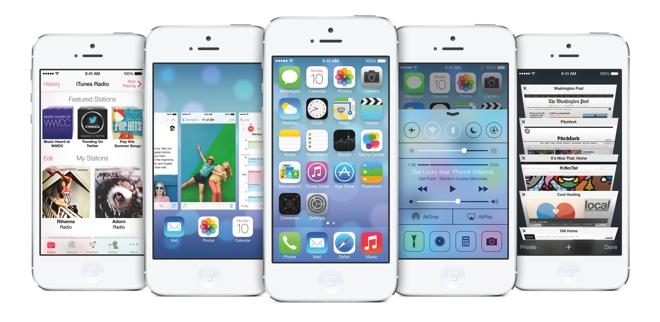
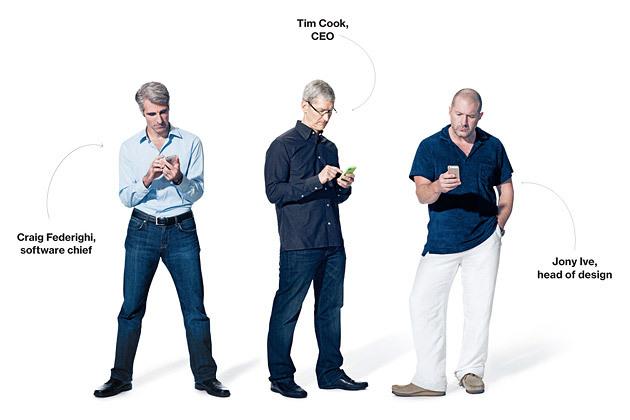
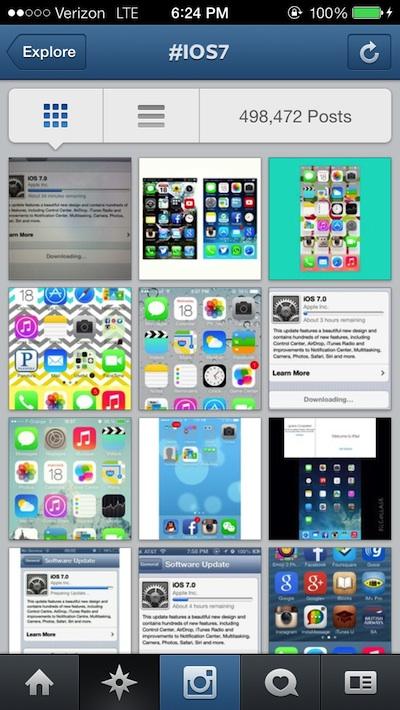
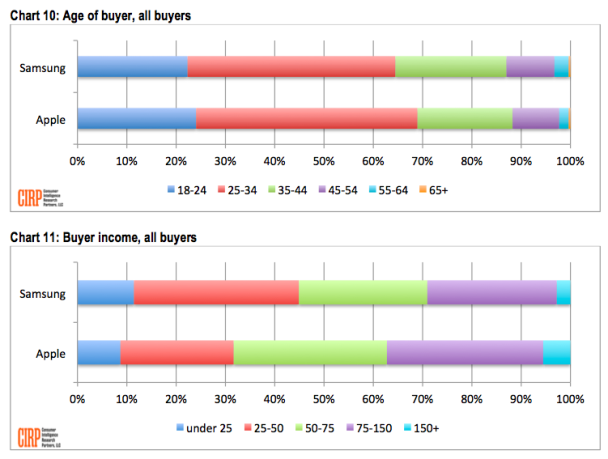

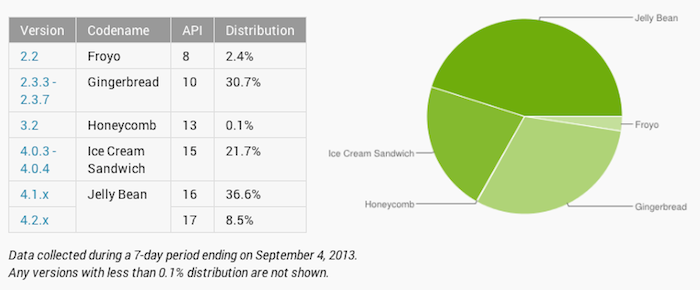







-m.jpg)






 Andrew Orr
Andrew Orr
 Malcolm Owen
Malcolm Owen
 William Gallagher
William Gallagher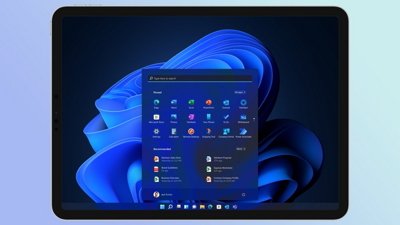

 Wesley Hilliard
Wesley Hilliard
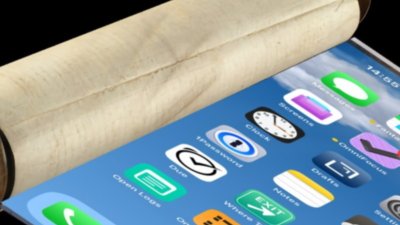


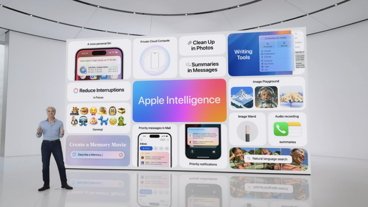


-m.jpg)




57 Comments
I love the part about 'they hated the wait', yet they managed to update the day it came out ....
[quote name="digitalclips" url="/t/159619/youth-lighting-up-twitter-facebook-instagram-about-ios-7#post_2400587"]I love the part about 'they hated the wait', yet they managed to update the day it came out ....[/quote] LOL. And now I have been confirmed, again, why I don't use social media. Have you seen those usernames? I think mine is lame here, but... [LIST] [*] attagirlkylie [*] deezy [*] Momma Long Legs [*] everyday_manday [*] Justin hasn't [*] Arrogant [*] ChieeffKeefSosa [*] [/LIST] ...and THAT is the last time I'll Samsung/Paste something from an article. The freaking 'Tag This Topic' popup is excruciating freaking annoying. What Freak implemented THAT? [IMG ALT=""]http://forums.appleinsider.com/content/type/61/id/31793/width/500/height/1000[/IMG]
Here's a cool site where you can get a sense of adoption rates. Already iOS 7 is around 25%. https://mixpanel.com/trends/#report/ios_7/from_date:-2,to_date:0 Based on message board comments (especially on MacRumors) I expected I wasn't going to like it; that I was going to be telling myself I liked it more than I really did. But to my surprise I actually do like it. Of course it's not perfect and I don't love everything about it (I didn't with iOS 6 either). But after using it for a few hours I wondered what all the angst was about. Using it again this morning it seems completely natural to use and I don't really miss iOS 6. But maybe the reason I have less angst is I'm treating it as a version 1.0 product. It's a complete redesign in the span of 7 months or so and it's just the beginning. Also a lot of the issues people are complaining about seem to be easily fixable. And maybe we'll see some of the rough edges smoothed out in point updates. I do think the current team under Cook will be more responsive to feedback than Jobs and Forstall were. One of my favorite things about iOS 7 is iTunes Radio. I used it for a couple hours last night and the song choices were great and I never had one repeat. On par with my Pandora experience and much better than the radio feature within Spotify. I can only imagine how good it will be once I've been using it longer and it's become acclimated to my tastes.
Ah, DED. Cherry-picks tweets for his article and then complains about survey bias. Total lack of self awareness.
Kids these days.. But some of this shit is actually pretty funny.neat to see what normal ppl think of ios7